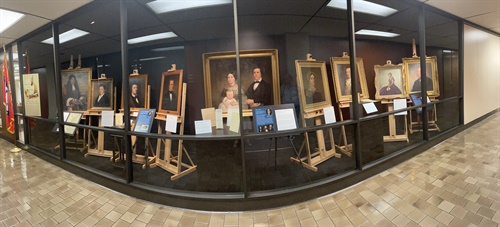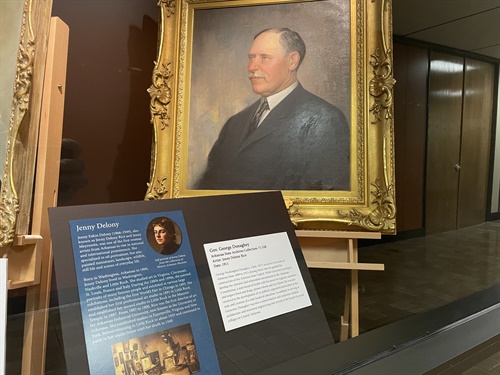Over the last few years visitors to the main facility of the Arkansas State Archives have had an opportunity to enjoy a visually and artifactually rich exhibit in our hallway display cases. The exhibit was created as part of the larger observance of the 100th anniversary of America’s participation in World War One; interpretive panels outlined Arkansas’s and Arkansawyers’ participation in the Great War while artifacts in the foreground introduced our patrons to one of our largest collections: more than one thousand battlefield relics collected by Louis C. Gulley, battlefield postmaster and, in his earlier years, a perceptive collector of Arkansas’s historic documents, several hundred of which he first loaned, then donated, to the young Arkansas History Commission and its secretary (and my predecessor), Dallas Herndon.
Gulley’s assortment of early Arkansas documents was the fundamental collection of the old History Commission and today it is finding a new audience: on our digital collection’s platform, scans of the Gulley Collection are systematically being supplemented with transcriptions, making life a little simpler for those of us whose cursive-deciphering skills have languished in recent years.
Gulley’s World War I collection was likewise a foundation of the History Commission’s offerings. For some years, the Commission exhibited what it styled “The Museum of the Great War” in the Arkansas Capitol’s hallways. Fragments of shell-shattered church ornamentation were exhibited alongside bullet-pierced helmets, gas masks, prisoner art and other evocative debris of war. When the History Commission removed to first the State House annex, then to One Capitol Mall, the war relics came along; they were finally once more brought to light in the State Archives’ commemoration of the war’s centennial.
Over the last few months, though, Curator Julienne Crawford has been at work on a replacement. It was certainly time: the exhibit had lasted longer in our cases than America's involvement in the war itself. And so, with encouragement from patrons and her colleagues on the staff, Crawford has carefully retired the exhibited relics while preparing their replacements. This new exhibit, “Brushed into History,” is in fact an opportunity for some of our longtime patrons to reencounter some “old familiar faces,” and for new friends to see unexpected things. During its years in the State Capitol. The Arkansas History Commission maintained the “Arkansas State History Museum,” an assortment of state history-related artifacts and artworks including a portrait gallery of distinguished Arkansians. The portraits came with the Commission to One Capitol Mall and have not been displayed for several years, but the pictures are carefully preserved by the State Archives, and we are happy to be able to have some of them see the light of day once again.
.png?sfvrsn=a9cb5464_0&MaxWidth=500&MaxHeight=500&ScaleUp=false&Quality=High&Method=ResizeFitToAreaArguments&Signature=68E1ABB21215C8B67D10DB9E0C2FBC4F7F488C84)
The subjects of the portraits span four centuries; they include men and women, swashbucklers and statesmen, individuals of artistic and argumentative leanings. The portraits include two by Arkansas’s arguably most famous artist, Edward Payson Washbourne, famed for his “Arkansas Traveler” genre painting. In the exhibit, the artist’s nuanced self-portrait is paired with his representation of his father, Presbyterian missionary Cephas Washburn, co-founder of Dwight Mission. In the center of the display is a peaceful family portrait of Arkansas lawyer, lawmaker, Governor, U.S. Senator and Attorney General Augustus Garland, depicted with his wife, Sarah Virginia, who holds one of their children; the future Arkansas leader endearingly holds a silver baby-rattle.

At either end of the exhibit are oversize portraits of two towering figures of Arkansas history. The west end is dominated by Ben Brantley’s 1935 copy of a much older portrait of Henri de Tonty, the Italian mercenary who served as LaSalle’s faithful and resourceful lieutenant, then in 1686 established a trading post at the confluence of the Black and Arkansas Rivers, which became the first persistent European settlement in the vast province of Louisiana: Arkansas Post. De Tonty would go on to establish other trading posts to the north; one, located on the shored of Lake Pimiteoui in 1691, formed the origin of today’s Peoria, Illinois. In 1702, De Tonty was chosen by officials of French Louisiana in Old Mobile (north of present-day Mobile, Alabama) as an ambassador to the Choctaw and Chickasaw nations. He continued in this position until August of 1704 when he contracted yellow fever and died at Mobile.

At the east end of the display, far removed from De Tonty, is a mover and shaker of a latter day: Jenny Delony Meyerowitz’s character-rich portrait of Arkansas governor George Washington Donaghey. The portrait was commissioned by the Arkansas Senate in 1911, presumably in gratitude for Donaghey’s forceful work for completion of the Arkansas Capitol For years, the portrait hung in the Governor’s Reception Room of the Capitol, then was replaced by one painted by N.R. Brewer. The differences in the portraits are striking. The Brewer image is of a grandfatherly, smiling clean-shaven Donaghey, seated comfortably with a paper in his hand. It radiates warm equanimity, a Donaghey both for the ages and with his mind on them. In contrast, the Meyerowitz portrait is of a younger man who does not gaze genially from the image; this is a head-and-shoulders image of someone with a forceful personality, the kind of individual needed when big or difficult projects are afoot. I recall reading, somewhere, that Donaghey once said that his motto was “set your watch ten minutes ahead and keep up with it”; the man in this picture looks up to the task.
***
A few days ago, I had the pleasure of attending a book talk and reading by the dependably engaging Arkansas cultural historian and promoter of All Foods Arkansan, Kat Robinson. She spoke at Little Rock’s Wordsworth Books in support of her latest offering, The Great Arkansas Pie Book, soon to appear in paperback. In two of her previous books she has focused on distinctive and distinguished Arkansas pies and where to find them; the current volume is a rich and sprightly cookbook, one that ought to be considered caloric all by itself. I confess to having presented copies of Ms. Robinson’s previous works to friends and relations who do not reside in these parts; they are as fun and revealing, in their way, as the old WPA guides to the states.
Listening to the author (and sampling some of her pumpkin and mincemeat pies after the reading) started me thinking about pies tied to places, people and memories; If Marcel Proust could have his memories stirred by tasting a madeleine cake dipped in tea, what might similarly provoke the rest of us? I cannot claim to have a single pie looming overlarge in my memories, but two have strong Arkansas connections for me. One was my first slice of an apple pie made fresh with Arkansas Black apples, brought into work by a colleague of mine in the Secretary of State’s office. As I recall that pie was divvied up into very slender slices; there were a lot of us who wanted a taste. I had heard of the Arkansas Black before this but had never tasted one; in the late nineteenth century this Winesap variant may have accounted for as much as ten percent of Arkansas’s apple production but today it is a relative rarity in the market. It is not extinct or even particularly threatened, just hard to find, particularly when you want one!
My other “Arkansas Pie” moment struck me a few years ago, when I was invited out to DeValls Bluff to give a talk. This was my first time in town and one of my fellow presenters asked me, with a twinkle in his eye, if I planned to stop at Ms. Lena’s for pie afterward.
All I need say is that one chocolate fried pie later, I was hooked. I have had a few—well, maybe more than a few—since, and many good ones, but that one had a flaky perfection to it that has lingered in memory. A pork sandwich from Craig Brothers’ Café, followed by a visit to Ms. Lena’s, makes a Saturday lunch that is hard to beat—and one that makes a detour into this historic community well worth taking.
.png?sfvrsn=a9cb5464_0&MaxWidth=510&MaxHeight=300&ScaleUp=false&Quality=High&Method=ResizeFitToAreaArguments&Signature=26DFF302458B38A72F1147F97C0DEA6E6A18E5D4)
